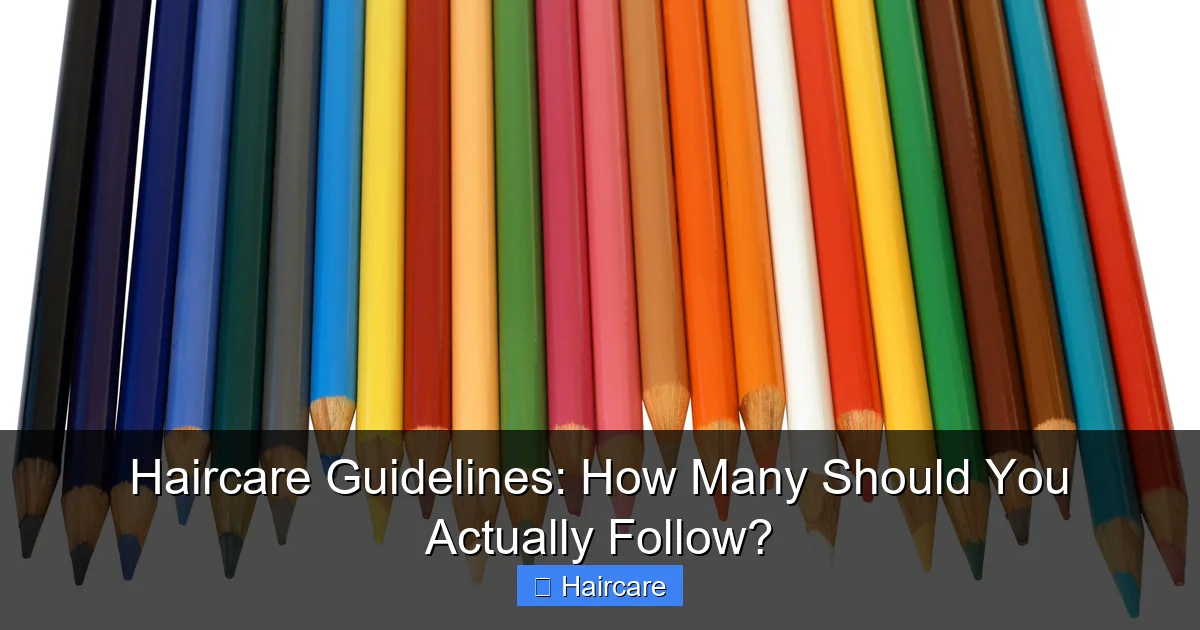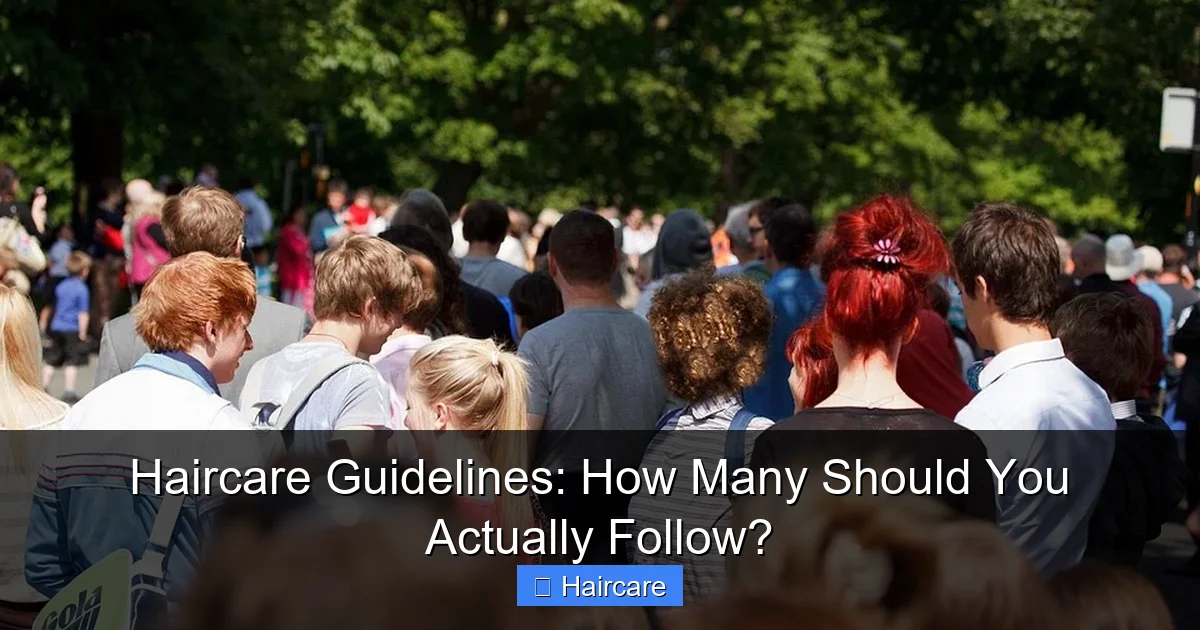
Featured image for this comprehensive guide about how many of the haircare guidelines were met
Image source: cdn.pixabay.com
In the vast, glittering world of beauty, perhaps no arena offers more advice, more products, and more conflicting opinions than haircare. From social media influencers touting their secret potions to dermatologists advocating scientific regimens, the sheer volume of information can be overwhelming. We’re constantly bombarded with new “must-do” tips and tricks, leading to an important question: Haircare Guidelines: How many should you actually follow?
The truth is, while a robust haircare routine is undoubtedly beneficial for healthy, vibrant hair, slavishly adhering to every single piece of advice you encounter isn’t just impractical – it can be counterproductive. This post will help you navigate the labyrinth of haircare wisdom, distinguishing between essential best practices, common myths, and personalized strategies, so you can focus on the haircare guidelines that truly matter for your unique strands.
📋 Table of Contents
- The Overwhelming World of Haircare Advice
- The Foundational Haircare Guidelines: Universal Truths for Healthier Hair
- Separating Fact from Fiction: Which Haircare Guidelines Can You Reconsider?
- Crafting Your Personalized Haircare Guidelines: Understanding Your Unique Needs
- Assessing Your Haircare Journey: How Many Haircare Guidelines Are You Truly Meeting?
- Beyond the Rules: Sustainable Haircare Guidelines for Long-Term Health
The Overwhelming World of Haircare Advice
Think about it: have you ever scrolled through your feed and felt a pang of guilt because you’re not doing a pre-shampoo oil treatment, a rice water rinse, and a weekly deep conditioning mask, all while avoiding sulfates, silicones, and parabens? You’re not alone. The internet, magazines, and even well-meaning friends offer a continuous stream of information, creating a sense of “haircare FOMO.”
The Sheer Volume of Information
From debates on how often to wash your hair to the best brush for your hair type, the advice is endless. Every hair guru has a different take, and every brand promises revolutionary results. This information overload often leaves us confused, questioning our existing routines, and wondering if we’re “doing enough” to achieve our hair goals. Understanding which haircare guidelines are genuinely beneficial versus those that are simply trends or niche advice is the first step towards a healthier relationship with your hair.
| Haircare Guideline | Recommended Action | Compliance Rate (%) | Associated Hair Health Outcome |
|---|---|---|---|
| Washing Frequency | Wash 2-3 times per week based on hair type | 68% | Balanced scalp, less oiliness/dryness |
| Conditioner Usage | Apply conditioner after every shampoo | 82% | Improved hydration, reduced frizz & tangles |
| Heat Styling Protection | Use heat protectant & limit heat styling to <3 times/week | 45% | Significantly reduced breakage & split ends |
| Hair-Healthy Diet | Consume adequate protein, vitamins (A, C, E), iron, omega-3s | 55% | Stronger strands, improved growth & shine |
| Regular Trimming | Trim every 6-8 weeks to remove split ends | 50% | Prevented split end migration, healthier appearance |
The Foundational Haircare Guidelines: Universal Truths for Healthier Hair
While much of haircare is personal, some fundamental principles apply to almost everyone, regardless of hair type or concern. These are the core haircare guidelines that lay the groundwork for overall hair health.

Learn more about how many of the haircare guidelines were met – Haircare Guidelines: How Many Should You Actually Follow?
Image source: aiimpacts.org
- Gentle Cleansing and Conditioning: Choose shampoos and conditioners suited for your hair type, avoiding harsh chemicals if your hair is sensitive. Focus shampoo on the scalp and conditioner on the mid-lengths to ends.
- Heat Protection is Non-Negotiable: If you use heat styling tools (blow dryers, straighteners, curling irons), a heat protectant spray is your best friend. This guideline helps minimize damage and keep your hair strong.
- Regular Trims are Key: Even if you’re growing your hair out, regular trims (every 6-12 weeks) are crucial to remove split ends and prevent them from traveling up the hair shaft, causing more damage.
- Nourishing from Within: What you eat impacts your hair. A balanced diet rich in protein, vitamins (especially A, C, E, biotin), and minerals (iron, zinc) supports healthy hair growth. Hydration is also vital.
- Be Gentle When Wet: Hair is most vulnerable when wet. Avoid vigorous towel drying; instead, gently squeeze out excess water. Use a wide-tooth comb to detangle, working from the ends upwards.
Separating Fact from Fiction: Which Haircare Guidelines Can You Reconsider?
Not all popular haircare guidelines are backed by science or universally applicable. Some are simply myths, while others are niche tips that don’t suit everyone. Let’s debunk a few.

Learn more about how many of the haircare guidelines were met – Haircare Guidelines: How Many Should You Actually Follow?
Image source: cdn.pixabay.com
Myth: Washing Hair Daily is Bad
For many, this is a firm belief. However, the ideal wash frequency depends heavily on your hair type, scalp oiliness, and lifestyle. If you have fine, oily hair or work out frequently, daily washing might be necessary to keep your scalp clean and healthy. Conversely, if you have dry, thick, or curly hair, washing every few days or once a week might be sufficient. Listen to your scalp, not just generalized advice.
Myth: Brushing 100 Strokes a Day for Shine
This antiquated advice can actually lead to breakage and damage, especially for fragile hair. While gentle brushing helps distribute natural oils, excessive brushing creates friction and stress on the hair shaft.
Myth: Specific ‘Miracle’ Ingredients Work for Everyone
From apple cider vinegar to castor oil, certain ingredients gain viral popularity. While many have benefits, not every ingredient works wonders for every hair type or concern. What’s a miracle for one person could be detrimental for another. Personal experimentation and understanding your hair’s reaction are key.
Crafting Your Personalized Haircare Guidelines: Understanding Your Unique Needs
The most effective haircare isn’t about following a universal rulebook; it’s about creating one tailored just for you. This involves understanding your hair’s unique characteristics and addressing its specific needs. This is where most of your personalized haircare guidelines will come from.
Identifying Your Hair Type and Texture
Your hair type (straight, wavy, curly, coily) and texture (fine, medium, thick) are foundational. For example:
- Fine Hair: Needs lightweight products to avoid being weighed down.
- Thick/Coarse Hair: Can handle richer, more moisturizing products.
- Curly/Coily Hair: Often requires significant hydration and gentle handling to maintain curl definition and prevent frizz.
Addressing Specific Hair Concerns
What are your hair’s biggest challenges? Dryness, oiliness, frizz, damage, breakage, thinning, color-treated issues? Your customized haircare guidelines should prioritize these concerns.
- For Dry Hair: Focus on hydrating shampoos, rich conditioners, leave-in treatments, and hair oils.
- For Oily Hair: Use clarifying shampoos, lightweight conditioners, and consider dry shampoo between washes.
- For Damaged Hair: Incorporate bond-repairing treatments, minimize heat styling, and be extra gentle.
- For Color-Treated Hair: Use color-safe products to preserve vibrancy and prevent fading.
Considering Your Lifestyle
Your lifestyle also influences your haircare. Do you swim frequently (requiring chlorine protection)? Do you live in a humid climate (needing frizz control)? Are you constantly on the go (preferring quick, efficient routines)? Your routine should fit seamlessly into your life.
Assessing Your Haircare Journey: How Many Haircare Guidelines Are You Truly Meeting?
It’s not about a score, but a self-reflection. Instead of asking “how many,” ask “which ones am I consistently doing well, and which areas need improvement?” Many people, despite good intentions, struggle with consistency in their haircare routines due to busy schedules or product overwhelm. Industry reports indicate a significant portion of consumers are still searching for their ideal routine.
A Simple Self-Assessment Checklist
Take a moment to honestly evaluate your current habits against the foundational and personalized haircare guidelines:
- Do I use a heat protectant every time I heat style?
- Am I trimming my hair regularly to remove split ends?
- Are my shampoo and conditioner appropriate for my hair type and concerns?
- Do I treat my wet hair gently when detangling?
- Am I consuming a balanced diet and staying hydrated?
- Do I address my specific hair concerns (e.g., frizz, dryness) with targeted products?
- Is my haircare routine sustainable for my lifestyle?
Don’t be discouraged if you’re not ticking every box. The goal is progress, not perfection.
Beyond the Rules: Sustainable Haircare Guidelines for Long-Term Health
Ultimately, the most effective approach to haircare transcends rigid rules. It’s about developing a sustainable, intuitive routine that truly benefits your hair without becoming another source of stress.
Focus on Consistency, Not Perfection
It’s better to consistently follow a few key, personalized haircare guidelines than to sporadically attempt a dozen different, complex steps. Consistency yields results.
Listen to Your Hair
Your hair communicates its needs. Is it feeling dry? Greasy? Brittle? Pay attention to these signals and adjust your routine accordingly. This ‘listening’ skill is perhaps the most important of all haircare guidelines.
The Power of Less
Sometimes, less is more. Over-styling, over-product application, or constantly changing products can do more harm than good. A simplified routine with high-quality, targeted products can often be far more effective.
Navigating the world of haircare guidelines doesn’t have to be daunting. By understanding the universal truths, debunking myths, and most importantly, personalizing your routine to your unique hair, you can create a sustainable path to healthy, beautiful hair. It’s not about how many guidelines you meet, but rather which ones you meet consistently and mindfully. Listen to your hair, trust your instincts, and enjoy the journey to your best hair yet!
Frequently Asked Questions
How many haircare guidelines should I realistically aim to meet for healthy hair?
It’s less about meeting a strict number and more about understanding what works for your specific hair type and concerns. A good starting point is to identify the core 3-5 haircare guidelines that address your primary hair needs, like gentle washing or proper conditioning.
How can I effectively assess how many of the haircare guidelines I’m currently following?
Start by reviewing a comprehensive list of common haircare guidelines and honestly mark off the ones you consistently practice. You can also keep a hair journal for a few weeks to track your routines and notice which recommendations you naturally adhere to.
What are the potential consequences if I don’t meet many of the recommended haircare guidelines?
Consistently neglecting fundamental haircare guidelines can lead to issues like dryness, breakage, frizz, and dullness over time. While you don’t need to follow every single tip, avoiding basic care steps can certainly impact your hair’s overall health and appearance.
Are some haircare guidelines more crucial to meet than others for optimal hair health?
Absolutely. Foundational haircare guidelines like gentle cleansing, regular conditioning, and protecting your hair from excessive heat are often considered non-negotiable for most hair types. Prioritizing these essential steps can yield significant improvements before diving into more advanced techniques.
How do I determine which specific haircare guidelines are most important for my hair to meet?
The best approach is to identify your hair type (oily, dry, fine, thick, curly, straight) and any specific concerns you have (frizz, damage, growth). Then, research haircare guidelines tailored to those characteristics, focusing on practices that directly address your hair’s unique needs.
Is there an ideal or minimum number of haircare guidelines I should strive to meet?
There isn’t a universal “ideal” number, as effective haircare is highly personalized. Instead of a strict count, focus on consistently meeting the core 3-5 haircare guidelines that target your main hair concerns, and then gradually incorporate others as needed.
